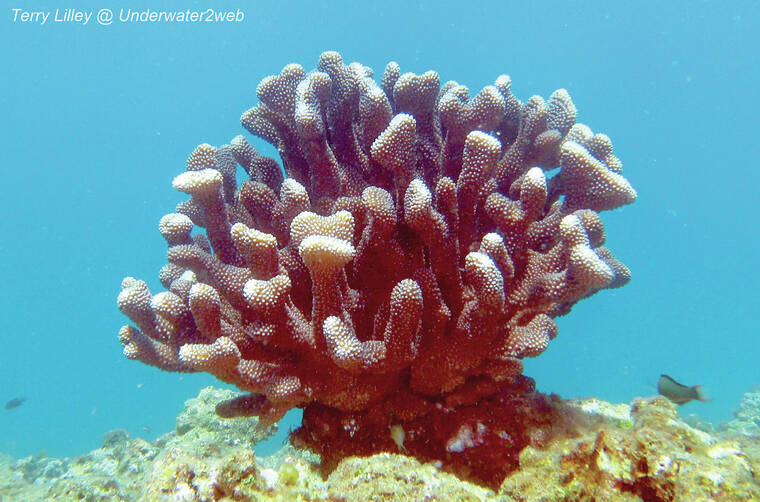Hanalei Bay is a complex ecosystem due to all of the rain we get along with large surf and a huge wetland area. Rivers that flow into tropical oceans usually create sand bars and coastal lagoons, much like you see with the Wainiha River in Kaua‘i.
The shifting river mouth is beneficial to the coral reef in Wainiha Bay because sediment from the river is never deposited on the same part of the reef for very long. The Hanalei River mouth used to meander up and down the beach until it was stabilized by people to protect their homes, roads and businesses.
Now the sediment from the river is deposited out on the reef at the same spot over and over — this is very difficult for coral growth.
When it rains hard in Hanalei, the river plus several streams empty mud, toxins, farm chemicals and sewage into the bay — this can kill the corals. The part of the reef where the river and streams flow out onto is often dead and void of any coral growth, but the parts of the reef that the runoff during storms misses is often quite healthy.
This patchwork of coral growth in Hanalei is tied directly to what the river and streams carries out onto the reef. If the river and streams are clean, the corals will not be affected because the sediment deposited during storms will wash away quickly due to the strong currents and surf.
I have been diving in Hanalei Bay for more than 15 years and have shot more than 300 hours of underwater movies of the corals and marine life. It has been an interesting study to see the corals grow and die, and then grow back many times over.
Over the past 20 years, the 2018 massive Hanalei Flood did more damage to the corals in Hanalei Bay then any other event. Most of the reef was wiped clean of any coral growth. This gave me the opportunity to study the reef and monitor any new coral growth after the flood.
The east side of Hanalei Bay has had very good coral growth since 2018. On a recent scuba dive, I shot video of more than 50 large antler and cauliflower corals and some are 2 feet tall.
These corals cause friction on the underside of the waves making the surf break better and be more hollow. The corals also act as a natural seawall breaking up the energy of the surf, so it does not cause excess erosion on the beach. More coral equals better waves and less erosion. As a surfer, I was super happy to see all the new coral growth in the last five years.
On the west side of Hanalei Bay, it is completely the opposite. The corals that were destroyed in the 2018 flood did not grow back and the reef is basically just covered in mud and algae. This tells us that something may be coming out of the streams on that side of the bay that would keep the corals from growing back. Chemical testing should be done to see what may be in the stream runoff. Without live coral on the Waipa side of the bay, the surf will not be as good and there will likely be more beach erosion.
Keeping Hanalei Bay coral healthy is a lot of hard work. Constant reef monitoring needs to be done along with chemical testing to make sure the river and streams are not depositing farm chemicals, sewage, heavy metals and excess sediment out onto the reef. Keeping the corals healthy will give us surfers better surf and the homeowners less beach erosion.
I am producing a time lapsed movie showing healthy corals in Hanalei Bay, then the corals dying and in parts of the bay regrowing over the past 15 years. In the movie, I will also document the flood events along with ocean water chemical testing we have done in the past, and show how the coral growth has effected the surf and beach.
If you would like to get all of my free underwater documentary movies, please sign up on my YouTube at Underwater2web.
•••
Terry Lilley is a marine biologist living in Hanalei Kaua‘i and co-founder of Reef Guardians Hawai‘i, a nonprofit on a mission to provide education and resources to protect the coral reef. To donate to Reef Guardians Hawaii go to www.reefguardianshawaii.org.


